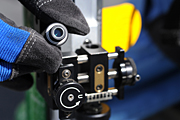- Number 313 |
- June 7, 2010
New INL technology should help marksmen line up their shots

The MicroSight's wafer-thin
optical element is only about
a quarter-inch in diameter.
Aiming a weapon is harder than it looks. Shooters need clear, sharp views of a distant object (the target) and a near one (the gun's iron sight) at the same time — a trick the eye can't pull off by itself. Telescopic and holographic sights can overcome this problem, but they tend to be bulky, expensive and fragile.
David Crandall, an engineer at DOE's Idaho National Laboratory, has devised an innovative solution that promises to be affordable, lightweight and effective. Crandall's MicroSight, a disc smaller than a dime, brings both target and iron sight into focus simultaneously through the power of zone plates. Zone plates focus light via a set of concentric rings that alternate between transparent and opaque. The transparent sections let some light waves pass through unchanged, focusing objects that are far away. But light passing the edges of the opaque rings gets diffracted, which brings nearby objects into focus as well.
The MicroSight could improve the accuracy of serious target shooters, who cannot use telescopic or holographic sights in competitions. The technology could aid hunters and soldiers, too, either as a primary aiming reference or as a lightweight, inexpensive backup for other types of sights.[Mike Wall, 208.526.0490,
Michael.Wall@inl.gov]
